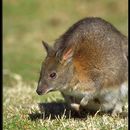-
Coral Sea, Duration 13 seconds
-
Description: Sent in by the crew of the PBLJ this movie clip and these images show a pod of Pilot Whales close to the rig seemingly swimming by as normal until they are disturbed, swim closer to the rig than normal, and shoot off in various directions.
Closer examination of the video footage kindly sent into SERPENT shows several Orca Killer Whales chasing the pod of Pilots and their younger calves. The Orcas have characteristic tall fins. Item Type: Video Title: Pilot whales and killer whales around rig Species: Globicephala melaena, Orcinus orca Behaviour: Pilot whales swimming on surface near rig. Killer whales arrive and appear to chase them. Pilot whales scatter. Site: Atlantic -- North Sea -- West of Shetland -- FoinavenNorth Sea -- West of Shetland -- Foinaven Site Description: Topside Depth (m): Surface Countries: UK -- West of Shetland Habitat: Open ocean Rig: Paul B Loyd Junior Project Partners: BP, Transocean, Subsea 7 Deposited By: Rob Curry Deposited On: 18 September 2007
-
South Pacific Ocean, Duration 265 seconds
-
Eastern Pacific Ocean, Duration 14 seconds
-
Coral Sea, Duration 22 seconds
-
Coral Sea, Duration 18 seconds
-
South Pacific Ocean, Duration 21 seconds
-
Eastern Pacific Ocean, Duration 26 seconds
-
Coral Sea, Duration 4 seconds
-
Coral Sea, Duration 21 seconds
-
South Pacific Ocean, Duration 32 seconds
-
Coral Sea, Duration 4 seconds
-
Eastern Pacific Ocean, Schooling, Duration 24 seconds, Shot includes Paranthias colonus (Pacific creole-fish)
-
Coral Sea, Duration 6 seconds
-
South Pacific Ocean, Duration 43 seconds
-
South Pacific Ocean, Duration 6 seconds
-
Coral Sea, Duration 4 seconds
-
Coral Sea, Duration 6 seconds
-
Coral Sea, Shot at night, Duration 9 seconds
-
South Pacific Ocean, Duration 98 seconds
-
Coral Sea, Duration 9 seconds
-
It's been three years â let's check in again with the marmots of Sunset Glade.
[taxonomy:binomial=Marmota flaviventris]
-
A young marmot family lives in the rockpile of Sunset Glade, in the Santa Fe ski basin.
http://www.marmotburrow.ucla.edu/YBAC.html
http://www.marmotburrow.ucla.edu/ybelly.html
[taxonomy:binomial=marmota flaviventris]
-
This one's (mostly) for fun.
Pikas can be pretty busy in the summertime, making haypiles, eating (and re-eating), and guarding against predators - and nosy videographers.
The music is "Dragonfly" by Pearl Django - http://www.pearldjango.com/ - and it suits these lagomorphs really well.
Thanks in part to their ability to withstand winter cold, pikas may be imperiled by warming climate. The evidence in this regard is as yet inconclusive, which may be why the U.S. Fish and Wildlife Service declined to list the American Pika as endangered in 2009.
Several science projects, including one run by the National Park Service, aim to improve our understanding of pikas and their climate sensitivity. Happily, the projects provide opportunities for citizen scientists:
http://science.nature.nps.gov/im/units/ucbn/monitor/pika/pika_peril/about.cfm
http://www.seventh-generation.org/citizen_science_pika.html
[taxonomy:binomial=ochotona princeps]

